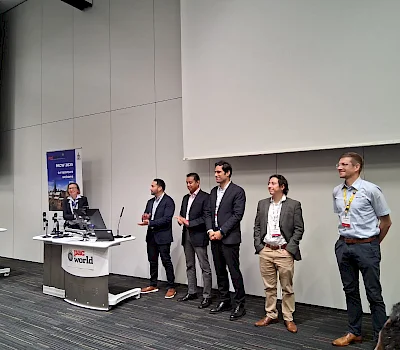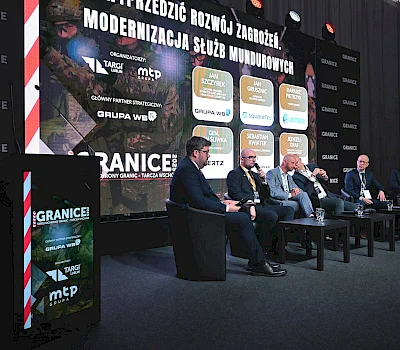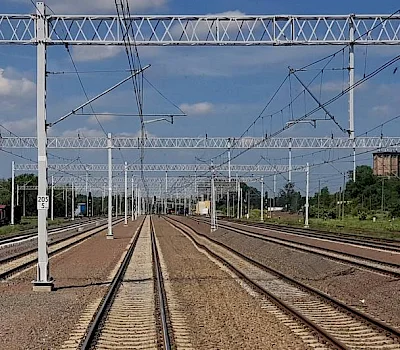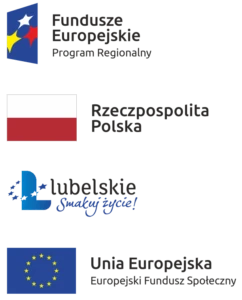Keywords: IEC 61850, GOOSE, power automation
The article describes how to develop a test bench using the capabilities of the IEC 61850 standard in digital substations equipped with
with equipment from various manufacturers. This testbed was demonstrated at the KAE 2022 conference and several companies participated in its development,
who developed unique methods to integrate their equipment in such a diverse environment. A key issue during the construction of the stand
was the development of the telecommunications circuit and ensuring correct time synchronisation, which is necessary for the correct operation of the
process bus.
In 2004, the IEC 61850 standard was developed and issued, introducing state-of-the-art technology, also in the field of secondary circuits for power automation. Its aim was to completely move away from current practices of building analogue secondary circuits, replacing them with Ethernet and digital solutions.
At the same time, the standard defines communication interfaces and protocols for automation devices in an attempt to bring about their unification and interoperability between devices from different manufacturers, which was a very complex issue in the run-up to its development. Even before it was officially published, the standard received a great deal of interest from automation device manufacturers. One could say that there was a race to achieve compliance with the new standard.
The situation was quite different when it came to operating practices among electric traffic companies. The implementation of the standard in actual facilities is usually met with great caution, as its introduction completely changes current practices and habits. This applies not only to the implementation of secondary circuits, but also to the ways in which they are commissioned, tested and operated. Most of the previous experience would have to be thoroughly revised and rebuilt. Currently, the standard is readily used in automation equipment for communication with the control system, in many fields replacing previously used telecommunication protocols such as 60870-5 or MODBUS, despite the fact that to date there are only a few digital substation installations in the world fully implementing the IEC 61850 standard.
The first implementations of the standard in substations were recorded in 2005 in Germany and Switzerland [4]. These were not process bus based implementations but only used selected elements of the standard, such as network configuration, communication stack (MMS), standardised functions (logic nodes), commissioning process and testing. Despite this, advantages were pointed out, such as the scalability of Ethernet or the reduction of telecommunication links, resulting in less time needed for task coordination, final acceptance and testing. In addition, the advantages of using standardised function names defined by the standard were noted - it was possible to move seamlessly from requirements definition to design as soon as the order was received, saving time and eliminating potential errors. The SCL station description language allowed the creation of security configuration templates, which reduced commissioning time. The complex wiring in individual
fields, replacing them with an Ethernet connection. This saved time in laying cables, cable trays and terminals. Another advantage is that tests of automation systems based on Ethernet connections can be performed completely in the laboratory. On-site tests only had to be repeated for wire connections.
Not all experiences of implementing the standard have always been problem-free, especially where equipment from different manufacturers was used to work together. A project that was intended to test interoperability between different devices was the construction of the La Venta II station in Mexico (2007) [2]. All the automation manufacturers were invited to join the project, with equipment from: SEL, ZIV, Siemens, GE, RuggedCom and Team ARTECHE. The other manufacturers either did not have IEC 61850-compliant equipment at the time or it had not passed initial approval. The intention of the project was to test the interoperability of equipment from different manufacturers within the IEC 61850 standard.
The initial design stages were followed by six weeks of factory tests. Already during the initial configuration of the network and communication, the first problems appeared, such as: the names of logical devices could not be edited, a lack of flexibility in the linking of variables to data objects, making it necessary to use a large number of generic logical nodes not provided for in the design and some IEDs did not support the required number of 6 simultaneous connections. Once the SSiN hubs and HMI workstations were up and running, the next phase of testing proceeded, during which further problems were noted: a lack of configurable reporting block names and a problem in writing designed values to OptFlds and TrgOps fields due to a lack of support for some of them. Some of the IEDs did not support the origin attribute, making it impossible to record where the control came from. Part of the problem was due not only to the implementation of individual devices, but also to the immaturity of the standard itself.
Over time, manufacturers gathered experience and improved their device implementations, as well as subsequent revisions of the standard were published. Based on more recent experience (2016) gained during the construction of one digital process bus-based station published in [9], it can certainly be said that the introduction of digital secondary circuits is no longer as cumbersome as it was at the beginning of the standard's emergence and can lead to significant time and cost reductions. It should be noted that these gains will increase with subsequent implementations, as the specificity of the standard allows for easy reuse of communication templates. Table I summarises the approximate times for the construction of the secondary circuits of the stations in the different techniques by task.
It can be seen a reduction in the total time required by using a digital station of 49%. There was also a significant reduction in costs through reduced cabling, lower installation and commissioning labour time. Better results are expected in future implementations, especially in the configuration phase of the IEDs, which was the only one found to be longer than the conventional automation system, due to the possibility of reusing the developed templates.
TABLE I. Comparison of time-consuming tasks performed in station construction by different techniques [9].

There have also been many implementations of the IEC 61850 standard in Poland ([1, 5, 6, 10]), where it is eagerly used today especially at the level of control and supervision systems, as well as the implementation of automatics such as ZS, LRW, SZR. The first fully digital substation using the process bus in Poland was the Oborniki Śląskie 110/20 kV substation, which was completed in 2019. [3].
Currently, the state of implementation of communication mechanisms at the level of equipment manufacturers is quite advanced and varies between equipment. One can see an advantage in the completeness of the implementation and its flexibility in devices designed from the beginning with IEC 61850 in mind over devices that are older designs, where IEC 61850 functions have been integrated into them at some stage of development. Communicating such devices is usually possible, but requires the right approach of matching a more flexible device with a device that has certain assumptions and limitations in its implementation. Establishing GOOSE communication between market-leading manufacturers of power automation devices was the aim of the interoperability position presented at the KAE 2022 conference.
DESCRIPTION OF THE INTEROPERABILITY TEST BENCH FOR EAZ EQUIPMENT
As part of the development of the presentation for the KAE 2022 conference, a number of companies manufacturing state-of-the-art protection devices were invited to collaborate on the development of a fully functional laboratory test bench. The following companies signed up for the project and delivered their devices with the IEC 61850 standard implemented:
- Schneider Electric - P5xx relay,
- Siemens - 7SA870 relay (with SV reception and SV flux generation capability),
- Hitachi - REL 670 relay (with SV reception capability) and SAM600 (merging unit),
- Elektrometal Energetyka - e2Tango,
- ZPrAE - TZO-11 relay (with SV reception capability) and TMU-11 merging unit,
- GE - D60 relay,
- Omicron providing microprocessor-based testers allowing current, voltage signals to be forced in analogue as well as digital SV form, and the analysis of frames transmitted over the LAN using the DANEO device,
- Bitstream, a company providing LAN network construction and time synchronisation based on its own solutions, the HYPERION 400 Ethernet switch and the HYPERION 500 multifunctional device equipped with a PTP clock.
A schematic diagram of the test system is presented in Fig. 1, showing the types of devices used and the implementation of telecommunications links. A more detailed realisation of the LAN using Bitstream equipment is shown in Fig. 2. It was decided to use the PRP mechanism for the telecommunications links, i.e. two independent networks ensuring high reliability of message transmission. Each of the supplied relays was able to operate in this communication mode. In addition, it was necessary to introduce time synchronisation frames into the network. This was the responsibility of the HYPERION 500 clock, which provided synchronisation in PTP and, optionally for selected devices, a 1PPS and NTP signal. Correct time synchronisation is crucial for the SV data streams that were present in the developed bench. All devices were installed in mobile 19" racks, which allowed the entire workstation to be easily moved. An overview view of the workstation is shown in Fig. 3. The physical links to the individual ports in the switches responsible for communication at LAN A and LAN B were mostly made in the form of multimode fibre connections. multimode fibre connections. The method of connection, the ports used and the types of connectors are shown in Figure 4.
The devices supplied for the construction of the station can perform various roles in the digital station. Some of them are typical security devices that can receive and send two-state signals transmitted as GOOSE messages. Others can additionally receive the SV stream or even create and broadcast it over the network. It was therefore necessary to ask how to present interoperability and what it should be about. This task was broken down into several requirements that had to be met. Interoperability in the sense of transferring PTP information (time synchronisation) between the PTP clock and the MUs and IEDs via the telecommunications equipment layout (Ethernet switches) is as follows:
- the source of the PTP frames containing the time information and allowing the MU and IED devices to achieve precise time synchronisation is the PTP clock (grandmaster clock), which has external synchronisation with the GPS system (external antenna),
- the frames of the PTP protocol can be structured in a different way depending on the version, which necessitated a proper adaptation of the configuration of the devices: IED, MU and clock and Ethernet switches involved in the synchronisation process (through which PTP frames are transmitted).
Interoperability in the sense of receiving GOOSE information from third-party devices such:
- each IED sends the status of a bit changed by a key press on its front panel,
- each IED shall indicate the sending of a bit of value 1 by the green colour of one LED on its front panel,
- each IED indicates receipt of a bit of state 1 from each of the other IEDs by the red colour of the LEDs on its front panel front panel.
Interoperability in the sense of receiving SV information from third-party MU devices looks like this:
- each MU device sends one stream of SV frames, containing samples of analogue signals measured locally at its inputs,
- one current input of each MU device was connected in series with the current output of the CMC tester,
- the current inputs of the MUs were connected in series with each other and connected to the current output of the CMC tester,
- each of the IEDs capable of receiving SV frames was configured to receive SV frames from each of the MUs,
- each of the IEDs capable of receiving SV frames has been configured to use the current samples transmitted in the SV frames for the overcurrent function,
- the operation levels of the overcurrent functions in the IEDs have been set to different values.
- each IED shows the operation of its overcurrent function with a red LED on the front panel.
Interoperability in the sense of transferring GOOSE and SV information between the IEDs through the telecommunications equipment system (Ethernet switches) is as follows:
- each MU and IED transmits data over two redundant Ethernet links using PRP technology,
- the transfer of data over the Ethernet links is carried out by the Ethernet switches, which had to be: equipped with the appropriate types of Ethernet ports (electrical, optical with the appropriate optical wavelengths, appropriate data exchange speeds - appropriate data encoding types) and configured accordingly so that data containing specific information (e.g. VLAN number, etc.) is transferred between the specified Ethernet ports.
DESCRIPTION OF SECURITY CONFIGURATION METHODS INSTALLED ON THE BENCH
Each manufacturer performed the configuration of their own relays in their respective tool applications. This involves, according to the example shown in Figure 5 (based on a Siemens device), preparing the relevant blocks - whether SV or GOOSE messages - and then exporting the scd/icd/iid files so that other manufacturers can read them into their own IEC 61850 configurators. This operation allows the output signals from one relay, e.g. REL670, to be associated with the input signals for a 7SA870 device, resulting in the possibility of interaction between devices from different manufacturers.

Figure 1: Schematic diagram showing the idea of a laboratory bench for demonstrating interoperability of IEDs [8].

Figure 2: Implementation of a LAN based on Bitstream devices using the PRP mechanism [7].
It therefore becomes necessary to achieve a situation in which the GOOSE or SV frames sent are understood by each relay connected to the station bus. The structure of the frame used is shown in Fig. 7 and Fig. 8. In the cases shown for relay REL670 and 7SA87, the frames have an identical structure, which is a condition for correct data exchange. A frame encapsulated in a structure consisting of three parameters: stVal, quality and time was used. Only such data could be correctly interpreted by all security devices and it was required that each manufacturer could define the data frame for GOOSE messages in this way.
In the case of the SV frame, its structure is shown in Figure 6. This is an example frame acquired from the SAM600 device. It is a stream with measurements for protection purposes, where sampling is done at 4 kHz, this gives us the sending of a frame with information about the values of 4 currents and voltages, every 250 μs. Each stream sent by any merging unit is identified by the target devices based on the svID parameter, which in this case was named SAM600MU0105. The presented frame structure was used in the laboratory bench and an identical structure was used for the other two units 7SD870 and TMU-11. The parameter identifying the different streams in this case was the svID name, individual for each data stream.
RESULTS OBTAINED
The construction of a laboratory bench demonstrating multi-vendor device interoperability was intended to answer some of the key interoperability questions raised in the earlier section. These related to the key issues to be resolved when building a digital substation. These are, respectively: confirmation of interoperability in the sense of transferring PTP information (time synchronisation) between the PTP clock and the MU and IED devices through the telecommunications equipment layout (Ethernet switches).

Fig. 3 Stand built using laboratory racks
Correct time synchronisation is crucial to ensure the correct operation of the EAZs, especially for the SV data streams that were present in the developed stand. This was the responsibility of the HYPERION 500 clock, which provided synchronisation in PTP and, optionally for selected devices, a 1PPS and NTP signal. The devices comprising the bench achieved correct synchronisation according to the data shown in Table II. Most of the IED devices allowed time synchronisation in the PTP standard. The SAM600 device was synchronised using 1PPS, but subsequent work in the laboratory of the Institute of Energy of the Warsaw University of Technology allowed confirmation of the possibility of synchronising these devices using PTP, which was confirmed by correct exchange of SV data with the 7SA87 relay.

Fig. 4. Ports and types of fibre optics used in the bench

Figure 5: Security configuration method using Siemens security as an example [8].

Figure 6: Example of SV data frame

Figure 7: Example of a GOOSE data frame from Hitachi's REL670 device.

Figure 8: Example of GOOSE data frame from a Siemens 7SA87 device.
TABLE II. Synchronisation types used for individual devices installed on the laboratory bench using the BitStream clock and switches (PUP - Power Utility Profile - IEC/IEEE 61850-9-3, NTP - Network Time Protocol).

The results obtained should be considered good. All the devices installed on the bench allowed for time synchronisation at a level sufficient to perform the functions assigned to them. In the case of the E2Tango relay, it allowed the exchange of GOOSE messages, and this type of time synchronisation (NTP) is sufficient for this type of function. The telecommunications chip supplied by BitStream met the requirements for ensuring correct synchronisation, and the HYPERION 500 clock allowed accurate time using a number of different standards including the 1PPS optical signal.
Another element tested on the bench was:
- Confirmation of interoperability in the sense of transmitting GOOSE and SV information between IEDs through the telecommunications equipment layout (Ethernet switches).
- Confirmation of interoperability in the sense of receiving GOOSE information from other manufacturers' devices.
- Confirmation of interoperability in the sense of receiving SV information from MU devices of other manufacturers.
As part of the work on building the laboratory bench, the ability of the telecommunications chip developed by BitStream to efficiently send GOOSE messages and multiple SV streams from several MU devices was confirmed. The manufacturers' representatives, based on configuration files obtained from the individual devices, led to the correct exchange of GOOSE messages between the devices shown in Table III. In most cases, in order to achieve a correct GOOSE exchange, it was sufficient to import the configuration files of the selected relay into another manufacturer's tool application and properly assign GOOSE signals. However, in some cases it was necessary to manually modify the scd/icd/iid files loaded into the IEC configurators.
Finally, after making the appropriate changes and sending the configurations to the relays, the correct exchange of GOOSE messages between all relays installed in the bench was achieved. This was demonstrated during the conference as the lighting up of successive indicator LEDs in the relays, corresponding to the reception of a GOOSE message from a selected device from another manufacturer.
There were also three MU devices from different manufacturers in the stand. These were respectively:
- SAM600 from Hitachi,
- 7SA87 from Siemens (MU function activated in the relay),
- TMU from ZPrAE.
The SV streams could be read by three relays equipped with this function. These were respectively:
- REL 670 from Hitachi,
- 7SA87 from Siemens,
- TZO-11 from ZPrAE.
All devices were properly configured and connected to the telecommunications network. Correct exchange of SV streams was achieved, as shown in Table IV. Each MU measured the currents and voltages fed from the Omicron tester and then sent the stream to the network. The relays responded to changes in the measured quantities by tripping the selected protection function and lighting the corresponding indicator diode. The results obtained confirmed the feasibility of using SV streams in devices from different manufacturers.
TABLE III. Interoperability test results for GOOSE message exchange, OK - correct GOOSE message exchange

TABLE IV. Interoperability test results for SV stream reading, OK - correct SV stream reading

SUMMARY
The construction of a laboratory bench demonstrating the interoperability of EAZ devices equipped with the IEC 61850 standard has been successfully completed. The feasibility of building a telecommunications network allowing efficient transmission of large amounts of data in the form of SV streams, GOOSE messages and accurate time synchronisation was confirmed. The practical possibility of exchanging GOOSE messages between IEDs from different manufacturers was confirmed. Of course, in some cases manual modification of configuration files is necessary, but in the end it was possible to link all protections in a common EAZ.
It is also possible to use SV streams in devices from different manufacturers. In this case, precise time synchronisation in all devices performing these functions is necessary, which has been achieved in this bench. The initiative to build a laboratory bench and the presentation of the possibilities of using the IEC 61850 standard in practical applications seems very valuable and crucial for the introduction of the new technology into practical applications in substations. Conferences thematically related to the field of protection automation gather many specialists, who can see first-hand the possibilities of the new technology, talk to specialists developing new systems, learn about the advantages and disadvantages of the new technology. It seems that the idea of building laboratory stands and presenting the current capabilities of relays as well as tool applications during EAZ engineering meetings should be continued.
Within the scope of this article, we would like to thank very much all the companies and people involved in the construction of the described stand - for the effort and time spent on the meetings and the physical construction of the stand. The commitment of the entire team led to the presentation of a fully functional EAZ system based on the IEC 61850 standard at the KAE 2022 conference.
Source: Wiadomości Elektrotechniczne, Yearbook 2023 - notebook 9
SIGMA-NOT Publishing
LITERATURE
[1] Banica D. 2016. Schneider Electric's experience in the implementation of digital substations based on IEC 61850/GOOSE technology. Electrical Engineering News, 9: 105-112.
[2] Flores V. M., D. Espinosa, J. Alzate, D. Dolezilek. 2007 Case Study: Design and Implementation of IEC 61850 From Multiple Vendors at CFE La Venta II, in 2007 60th Annual Conference for Protective Relay Engineers: 307-320 (DOI: 10.1109/CPRE.2007.359908).
[3] Floryn J. 2020. 110/20 kV Oborniki Śląskie substation made with process bus and substation bus technology - first experiences. Electrical Engineering News, 8: 26-30.
[4] Hoga and Skare. 2006. IEC 61850 Projects in Germany and Switzerland, in 2005/2006 IEEE/PES Transmission and Distribution Conference and Exhibition: 390-393 (DOI: 10.1109/TDC.2006.1668524).
[5] Hoppel M. 2015. SE Wielowieś in IEC 61850 - next steps. Electrical Engineering News, 3: 54-56.
[6] Kulski K. 2016. Digital substation - experience from the first project implementations in Poland and Lithuania. Electrical Engineering News, 12: 28-32.
[7] Materials provided by BitStream in preparation of the laboratory workstation.
[8] Materials provided by Siemens in preparation of the laboratory bench.
[9] Shoarinejad S., J. Seco, J. Cardenas. 2016. "The azerbaijani experiences in digital substation deployment. How process bus and IEC 61850 addresses utility requirements". 13th International Conference on Development in Power System Protection 2016 (DPSP): 1-6, (DOI: 10.1049/cp.2016.0059).
[10] Sitkiewicz R. 2011. protection automatics using GOOSE in IEC 61850 for MV switchgear on the example of RS Grzybowa. Electrical Engineering News, 10: 45-48.










